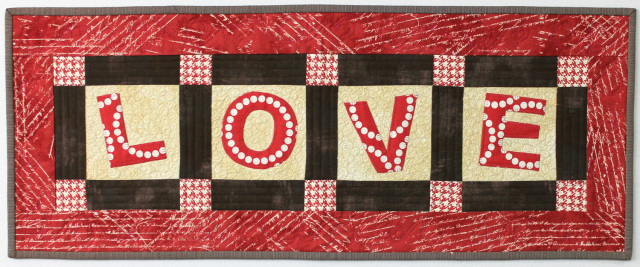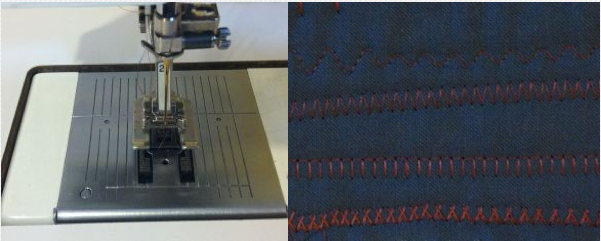Would you like to add a little more love to your home? Practice your sewing, quilting and machine appliqué techniques with this festive quilted table runner tutorial, just in time for Valentine's Day!

Designed, Pieced and Quilted by Christa Watson
Quilted table runner tutorial
Finished size measures 12" x 30"
Materials needed:
- 1 Fat Quarter for background
- 1 Fat Quarter for letters
- 1 Fat Quarter for small corner squares
- 1 Fat Quarter for sashing
- 1/3 yard for border (or 1 FQ if you don’t mind a pieced border)
- 1 Fat Quarter for binding
- 1/2 yard fabric for backing
- 18″ x 34″ piece of batting
- Piece of fusible web at least 8 1/2″ x 11″
- Thread to match your appliqué letters
- Matching thread for machine quilting (cotton or polyester)
Step 1: Cut the Fabric
- Cut (4) - 5″ squares of background (cream)
- Cut (4) - 4.5″ squares for letters (red)
- Cut (10) - 2″ small corner squares (red gingham)
- Cut (13) - 2″ x 5″ rectangles for sashing (dark brown)
- Cut (2) - 2.5″ x 8″ strips for side borders (red script)
- Cut (2) - 2.5″ x 30″ strips for top/bottom borders (red script)
- Cut (3) – 2.25″ x WOF (Width of Fabric) strips for binding (brown stripe)
- Cut 14″ x 32″ piece of batting
- Cut 16″ x 34″ piece of fabric for backing
Step 2: Prepare the L-O-V-E letters
Flip your paper over so that your letters are backwards. Trace the backwards letters onto the paper side of your fusible web.

Rough cut around each fusible paper letter. Then, following the manufacturer's instructions, adhere your fusible web to the backside of your letter fabric. Use this phrase: rough to wrong. The rough (glue) side of the web needs to be stuck to the back (wrong) side of your fabric.
Cut out the letters following their outlines. Don’t forget to cut out the center of the O! You have now made your own iron-on appliqués. The paper backings should still be attached.

Step 3: Assemble the quilt top
Join your cut pieces into three rows as shown below:

You will notice I have not added the letters yet. I like to add them once the top is done so I can space them just right. Press seams open or toward the sashing fabric.

Join the rows and add side borders that are trimmed to size. Then add the top and bottom borders and press toward the border fabric.

Remove the backing from your cut out letters. Following the manufacturer's instructions, adhere them to your block backgrounds. You can eyeball them in place, arrange them whimsically, or use a ruler to measure exact placement. It’s up to you!
Step 4: Baste your quilt
Using safety pins, straight pins or basting spray, baste your quilt. Take care not to pin through any of the letters.

Step 5: Practice your machine appliqué stitch

Use an open toe sewing machine foot and a wide needle plate if you have them, and select a thread color to match your fabrics. Stitch out a few designs on a practice scrap to see what you like. I prefer to use a blanket stitch on my machine. It adds a softer appearance to the appliqué shapes compared to a dense satin stitch. It's also more forgiving to stitch out.
Learn the “rhythm” of your stitch so you can anticipate where the needle will next pierce your fabric. Sew slowly and “count” how many movements it takes to complete the decorative stitch so you will know when to pivot.
Step 6: Appli-quilt your letters
Since you will be stitching through all the layers of your quilt, you don’t need a stabilizer. I suggest using the same thread color in the bobbin as well as the top to hide any less-than-perfect stitching or tension issues.

Start in the middle of your letter and bring the bobbin thread up to the top. Take a few small straight stitches to lock your threads. Then switch to the decorative stitch on your machine. You may need to scoot your quilt over so the needle position lines up correctly.

Anticipate where your needle will pierce the fabric on each movement of the stitch. Turn the top slowly and smoothly as needed so as to avoid stitching outside the letters into the background. If you have the “needle down” function on your machine, use it. Always stop with your needle down before turning your quilt. Pivot when needed.

When you have an inside turn, try to land your stitch right in the middle. Don’t be afraid to pivot every stitch or two when needed to completely outline the letters.

When you reach the beginning, change back to a straight stitch and end with a few small locking stitches. Clip your threads close. When you get to the ‘O’ stitch the inside first.
Finish stitching all of the letters the same way.
Step 7: Finish quilting your quilt
Now you can have fun machine quilting the rest of your runner however you like. I like to add a lot of quilting to my quilts, and the background fabric can give you a chance to add a lot of texture.

I stitched in the ditch with a thin matching polyester thread, quilted paisleys in the backgrounds with high-sheen polyester in cream, added a fun heart loop motif in the border with high-sheen heavy polyester and quilted the straight brown accent lines in cotton. I use whatever thread I have that will match best!
 Step 8: Bind your quilt
Step 8: Bind your quilt
Mimi Dietrich's Finishing School: Edges & Bindings is a wonderful resource for learning how to finish your quilts by hand or machine.
You might also enjoy our roundup of heart quilts for Valentine's Day.
Tomorrow on the Craftsy blog, we'll be sharing our favorite FREE Jelly Roll quilt patterns!

Share tips, start a discussion or ask other students a question. If you have a question for an expert, please click here.
Already a member?
No Responses to “How to Quilt a Table Runner You'll Absolutely L-O-V-E”